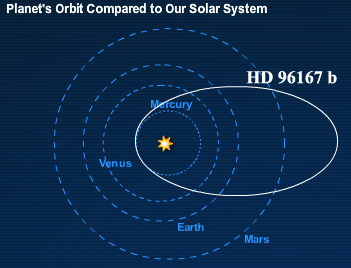eccentric Jovians

Eccentric Jupiter HD 96167 b has a comet-like orbit.
Eccentric Jovians, also called eccentric Jupiters, are exoplanets with a mass similar to or greater than that of Jupiter, which move around their host stars in highly elongated orbits. They include the planetary companions of 70 Virginis, 16 Cygni B and HD 114762, which range in mass from 1.74 to 10 times that of Jupiter and in orbital eccentricity from about 0.25 to 0.68.
The discovery of these objects, together with that of another unexpected class of extrasolar planets, the epistellar Jovians, has prompted a revision of contemporary theories about how planets are formed (see planetary systems, formation).1 According to one new hypothesis, the gravitational forces exerted by protoplanets on the material of the surrounding protoplanetary disk create alternating spiral density waves, like those which, on a much larger scale, give rise to the arms of a spiral galaxy. These waves then act back on the forming planets, pushing them out of their circular orbits into ones of higher eccentricity.
A second hypothesis assumes that, in some cases, a young planetary system starts out with several "super-planets", each one at least as massive as Jupiter. The powerful gravitational interactions between these giant worlds causes them to be thrown around, so that they may end up in highly eccentric orbits, some of them lying close to the central star, others much farther out. An interesting prediction of this model, therefore, which can be tested, is that a system containing one eccentric Jovian close to the host star should contain at least one more massive planet, probably lying much further out.
Reference
1. Ida, S., and Lin, D. "On the Origin of Massive Eccentric Planets," Bulletin of the American Astronomical Society, 28, 1112 (1996).


